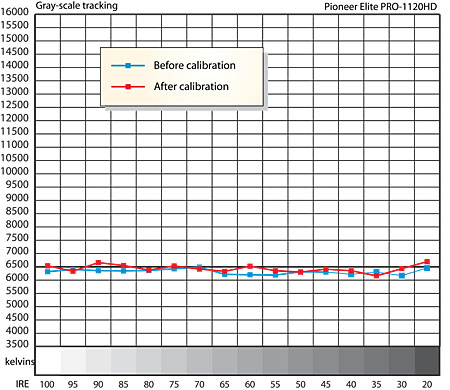Pioneer Elite PRO-1120HD Plasma Display System Calibration and Testing

Out of the box, the Low setting of the Color Temperature control was the closest to the D65 standard (see "Before" in the accompanying table). After calibration, the result was just marginally better than the as-delivered Low setting. The actual x,y coordinates of each point are shown also. A final tweak to optimize the gray scale for a DRE setting of Low (which I preferred to Off) did degrade the color-temperature numbers slightly, but not enough to produce a visible difference in the gray scale. The Low DRE setting reduced the panel's light output to 41fL (from 46fL in the Off setting) without obviously degrading the image contrast.
The color points were measured with an NTSC source; the ATSC primary color point standards are shown in the table for information. The red color point was very close to the standard, while the green was a little too rich. (The standard green color point for both NTSC and ATSC is actually more yellowish-green than in the Pioneer and many other digital displays, which may explain the vivid, mega-greens we often see from these products.) Blue is a little too deep into blue and not quite as purplish blue as it should be. That may sound peculiar, but a too-blue position of the blue color point slightly limits a display's ability to reproduce purplish-blue.
The Pioneer's overscan measured about 3% on all sides in 720p from our HD signal generator (component connection), and slightly more with a 480i component connection (3.5% at the left, 4% at the right, from DVD) and 480p DVI (4.5% bottom, from DVD).
Resolution patterns looked extremely crisp, with high-definition test patterns producing over 700 lines per picture height in 1280 x 720p and 1920 x 1080i. DVD produced 480 lines per picture height and responded cleanly up to the 6.75MHz luminance bandwidth limit of the format.
With a 480i component connection from the Panasonic DVD player, the Pioneer quickly captured the 3:2 pulldown sequence from the Video Essentials test DVD. On the Faroudja test disc, the Pioneer's internal deinterlacer/scaler produced a minimum of jagged edges; in fact, the waving flag looked arguably sharper than with the Faroudja deinterlacer built into the Panasonic's progressive output chain. It wasn't as completely free of jagged-edge artifacts as the Faroudja, but you had to look hard to see them. Pioneer's deinterlacer does not completely capture the unflagged 3:2 pulldown test on this same disc (a criticism that has been leveled at the deinterlacers in Pioneer's own DVD players, which rely on coded flags to tell them when to switch to film mode). The PRO-1120HD's performance on the film-over-video test was excellent, but video over film produced some line structure in the scrolling letters). The bad-edit detection was very good, as was the performance on the Silicon Optix HQV Benchmark DVD (version 1.2). Overall, the Pioneer's deinterlacing/scaling scored very good, though not quite excellent.
The Pioneer produced a measured peak contrast reading of 171 (17.45fL full-field white, 0.12fL full-field black). Since plasmas invariably produce far less output with a full white field than a white window, I also measured a peak contrast using a 10% window reading rather than a full field, with a resulting peak contrast of 474. The display's ANSI contrast (16-square checkerboard) measured 155 in a dark gray room environment (darker than the average room but not laboratory black).—TJN
- Log in or register to post comments










































